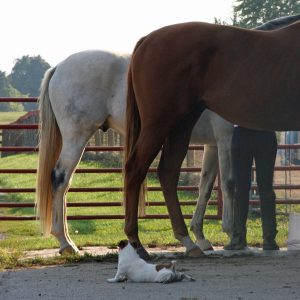
Research Confirms It: Tall Horses Are More Likely to Roar
Roaring (recurrent laryngeal neuropathy or RLN) occurs when part of the larynx is paralyzed, blocking the airway. As the horse inhales, there is a distinct sound. Roaring has a negative effect on performance as it reduces airflow during peak exertion. Resent research now confirms what field observations suspected: Taller horses are more likely to become roarers.
The study was conducted at Michigan State University and Cornell University with 505 TB horses and is both the largest body size genome-wide association study (GWAS) and the largest RLN GWAS in Thoroughbred horses to date. Height measurements, endoscopic exams, and gene mapping were performed on each horse. Evaluation of the data revealed that the genomes related to height and RLN overlap, which tells researchers that these two factors are most likely genetically linked.
The prevalence of RLN is known to be between 2%-11% in Thoroughbreds and 35%-46% in draft horses, with taller individuals (16.2 hh and above) exhibiting higher risk factors for RLN. Warmbloods are also most likely affected in a similar manner.
Research of this type improves our understanding of the connections between genetics and RLN. Such knowledge positively impacts the development of improved treatment and management options in the future.
Reference:
Genomic analysis establishes correlation between growth and laryngeal neuropathy in Thoroughbreds.
Boyko AR, Brooks SA, Behan-Braman A, Castelhano M, Corey E, Oliveira KC, Swinburne JE, Todhunter RJ, Zhang Z, Ainsworth DM, Robinson NE.
BMC Genomics 2014, 15:259 doi:10.1186/1471-2164-15-259



1 Comment
Pingback
[…] From the KPP Tips & Topics Blog: […]